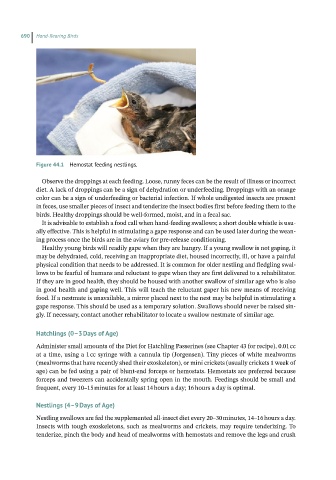Page 689 - Hand rearing birds second
P. 689
690 Hand-Rearing Birds
Figure44.1 Hemostat feeding nestlings.
Observe the droppings at each feeding. Loose, runny feces can be the result of illness or incorrect
diet. A lack of droppings can be a sign of dehydration or underfeeding. Droppings with an orange
color can be a sign of underfeeding or bacterial infection. If whole undigested insects are present
in feces, use smaller pieces of insect and tenderize the insect bodies first before feeding them to the
birds. Healthy droppings should be well‐formed, moist, and in a fecal sac.
It is advisable to establish a food call when hand‐feeding swallows; a short double whistle is usu-
ally effective. This is helpful in stimulating a gape response and can be used later during the wean-
ing process once the birds are in the aviary for pre‐release conditioning.
Healthy young birds will readily gape when they are hungry. If a young swallow is not gaping, it
may be dehydrated, cold, receiving an inappropriate diet, housed incorrectly, ill, or have a painful
physical condition that needs to be addressed. It is common for older nestling and fledgling swal-
lows to be fearful of humans and reluctant to gape when they are first delivered to a rehabilitator.
If they are in good health, they should be housed with another swallow of similar age who is also
in good health and gaping well. This will teach the reluctant gaper his new means of receiving
food. If a nestmate is unavailable, a mirror placed next to the nest may be helpful in stimulating a
gape response. This should be used as a temporary solution. Swallows should never be raised sin-
gly. If necessary, contact another rehabilitator to locate a swallow nestmate of similar age.
Hatchlings(0–3Daysof Age)
Administer small amounts of the Diet for Hatchling Passerines (see Chapter 43 for recipe), 0.01 cc
at a time, using a 1 cc syringe with a cannula tip (Jorgensen). Tiny pieces of white mealworms
(mealworms that have recently shed their exoskeleton), or mini crickets (usually crickets 1 week of
age) can be fed using a pair of blunt‐end forceps or hemostats. Hemostats are preferred because
forceps and tweezers can accidentally spring open in the mouth. Feedings should be small and
frequent, every 10–15 minutes for at least 14 hours a day; 16 hours a day is optimal.
Nestlings(4–9Daysof Age)
Nestling swallows are fed the supplemented all‐insect diet every 20–30 minutes, 14–16 hours a day.
Insects with tough exoskeletons, such as mealworms and crickets, may require tenderizing. To
tenderize, pinch the body and head of mealworms with hemostats and remove the legs and crush

